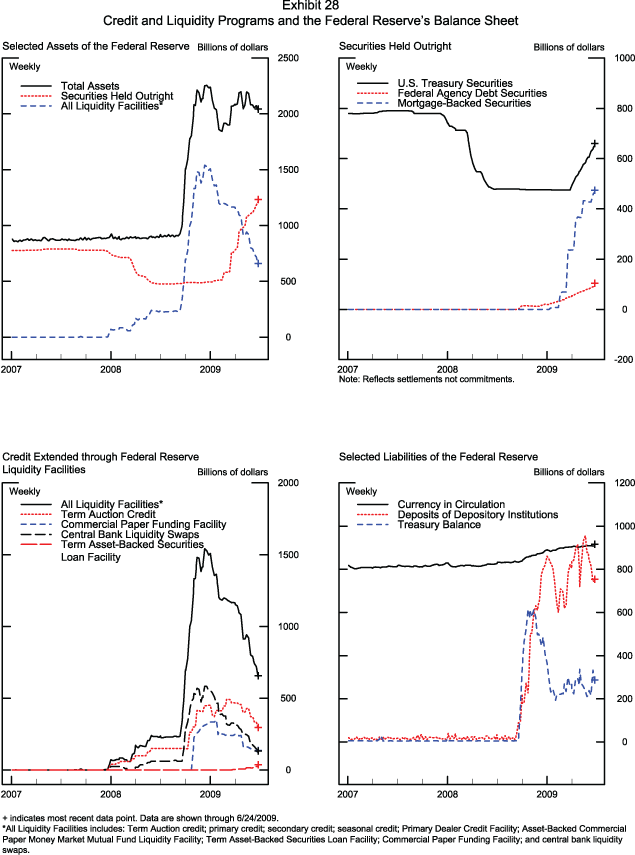Home
> Monetary Policy
> Quarterly Report on Federal Reserve Balance Sheet Developments
> Monthly Report on Credit and Liquidity Programs, 2009
> CLBS Report, July 2009


Monthly Report on Credit and Liquidity Programs
and the Balance Sheet
July 2009 (1.4 MB PDF)
| Purpose | Overview | SOMA Holdings and Liquidity Swaps |
Overview
Recent Developments
- In the four weeks since the last monthly report, continued improvements in financial market conditions have been accompanied by further declines in credit extended through many of the Federal Reserve's liquidity programs.
- On June 25, the Federal Reserve announced the extensions through February 1, 2010, of the Asset-Backed Commercial Paper Money Market Mutual Fund Liquidity Facility (AMLF), the Commercial Paper Funding Facility (CPFF), the Primary Dealer Credit Facility (PDCF), the Term Securities Lending Facility (TSLF), and the temporary reciprocal currency arrangements (swap lines) with other central banks. The current expiration dates for the Money Market Investor Funding Facility (MMIFF) and the Term Asset-Backed Securities Loan Facility (TALF) remain set at October 30, 2009, and December 31, 2009, respectively. The Federal Reserve also announced that some TSLF auctions will be suspended, that Term Auction Facility (TAF) auction amounts will be reduced from $150 billion to $125 billion, and that an additional administrative criterion was added for the AMLF.
- The Federal Reserve has continued to purchase large volumes of Treasury, agency, and agency-guaranteed mortgage-backed securities (MBS) under its large-scale asset purchase programs.
- TALF subscriptions in June were approximately $11 billion, supporting primary issuance of 13 asset-backed securities (ABS) deals worth a total of about $16 billion. There were approximately $5 billion in loan requests at the TALF operation on July 7; these requests supported issuance of nine ABS deals worth a total of about $12 billion.
- While the level of reserve balances remains quite high, the drop in use of various lending programs over the past four weeks has resulted in a net decline in reserves.
Table 1. Selected Assets, Liabilities, and Capital Accounts of the Federal Reserve System
($ billions)
| Item |
Current June 24, 2009 |
Change from May 27, 2009 |
Change from June 25, 2008 |
|---|---|---|---|
| Total assets | 2,028 | -54 | +1,133 |
| Selected assets: | |||
| Securities held outright | 1,217 | +110 | +738 |
| U.S. Treasury securities1 | 653 | +53 | +174 |
| Agency securities1 | 97 | +17 | +97 |
| Agency-guaranteed mortgage-backed securities2 | 467 | +40 | +467 |
| Memo: TSLF | 7 | -21 | -98 |
| Lending to depository and other financial institutions | 348 | -89 | +183 |
| Primary, secondary, and seasonal credit | 49 | +11 | +35 |
| TAF | 283 | -90 | +133 |
| PDCF | 0 | 0 | -2 |
| AMLF | 15 | -11 | +15 |
| Foreign central bank liquidity swaps3 | 119 | -62 | +57 |
| Lending through other credit facilities | 149 | -16 | +149 |
| CPFF4 | 124 | -25 | +124 |
| TALF | 25 | +10 | +25 |
| Support for specific institutions | 105 | -1 | +105 |
| Credit extended to AIG5 | 43 | -1 | +43 |
| Net portfolio holdings of Maiden Lane I, II, and III6 | 62 | 0 | +62 |
| Total liabilities | 1,980 | -57 | +1,126 |
| Selected liabilities: | |||
| Federal reserve notes in circulation | 867 | -3 | +79 |
| Deposits of depository institutions | 745 | -132 | +732 |
| U.S. Treasury, general account | 79 | +68 | +75 |
| U.S. Treasury, supplementary financing account | 200 | 0 | +200 |
| Other deposits | 5 | +5 | +5 |
| Total capital | 48 | +3 | +8 |
Note: Unaudited. Securities loans under the TSLF are off-balance-sheet transactions. TSLF loans are shown here as a memo item to indicate the portion of securities held outright that have been lent through this program. Components may not add because of rounding.
1. Face value. Return to table
2. Current face value, which is the remaining principal balance of the underlying mortgages. Return to table
3. Dollar value of the foreign currency held under these agreements valued at the exchange rate to be used when the foreign currency is returned to the foreign central bank. Return to table
4. Book value of net portfolio holdings, includes commercial paper holdings, net, and about $4 billion of other investments. Return to table
5. Excludes credit extended to Maiden Lane II and III. Return to table
6. Fair value, reflecting valuations as of March 31, 2009. Fair value reflects an estimate of the price that would be received upon selling an asset if the transaction were to be conducted in an orderly market on the measurement date. Fair values are updated quarterly. Return to table
1. Face value. Return to table
2. Current face value, which is the remaining principal balance of the underlying mortgages. Return to table
3. Dollar value of the foreign currency held under these agreements valued at the exchange rate to be used when the foreign currency is returned to the foreign central bank. Return to table
4. Book value of net portfolio holdings, includes commercial paper holdings, net, and about $4 billion of other investments. Return to table
5. Excludes credit extended to Maiden Lane II and III. Return to table
6. Fair value, reflecting valuations as of March 31, 2009. Fair value reflects an estimate of the price that would be received upon selling an asset if the transaction were to be conducted in an orderly market on the measurement date. Fair values are updated quarterly. Return to table
Figure 1. Credit and Liquidity Programs and the Federal Reserve's Balance Sheet
Last update:
August 2, 2013


 Policy Implementation
Policy Implementation

